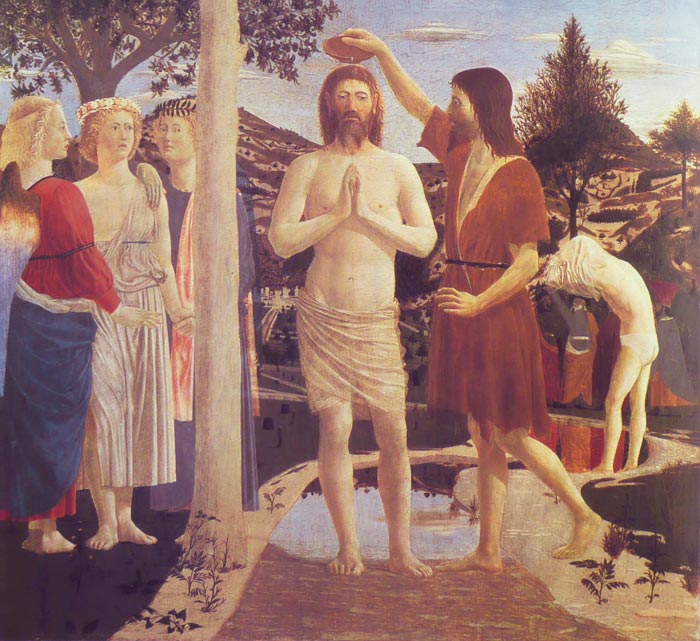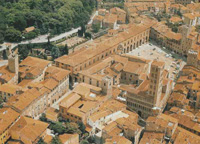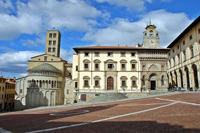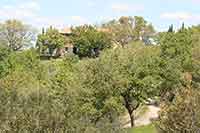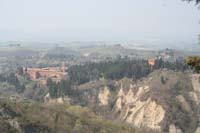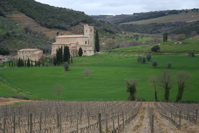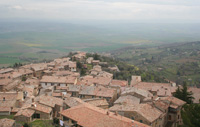| |
|
The Baptism of Christ is a good introduction to Piero della Francesca's style. Within an arched frame the baptism is taking place in a landscape strikingly similar to the countryside around San Sepolcro. In 1442 Piero della Francesca was recorded as town councillor in Borgo San Sepolcro. This painting is his first important commission in this period. Originally it was painted for the Chapel of San Giovanni in the Pieve. The panel was commissioned by the Camaldolese abbey of Sansepolcro, originally part of a triptych. Its dating to Piero della Francesca's early career is evidenced by the strong relationship with the "light painting" of his master, Domenico Veneziano.
This panel was the central section of a polyptych. It may be one of Piero's earliest extant works. Side panels and a predella were painted in the early 1460s, by Matteo di Giovanni (active 1452; died 1495). The altarpiece was in the chapel of Saint John the Baptist in the Camaldolese abbey (now cathedral) of Piero's native town, Borgo Sansepolcro.
Piero della Francesca was born in Borgo Sansepolcro. He worked in various central Italian towns, but retained links with Sansepolcro, visible in the background of the 'Baptism of Christ'. The town, visible in the distance to the left of Christ, may be meant for Borgo Sansepolcro: the landscape certainly evokes the local area.
The dove symbolises the Holy Spirit. It is foreshortened to form a shape like the clouds. God the Father, the third member of the Trinity, may originally have been represented in a roundel above this panel.
The most striking feature of this painting is the extraordinary lighting from above, creating delicate pastel colours, with pale shadows that surround the figures and enhance their three dimensionality. At the centre, the figure of Christ is portrayed as a simple man, but his stance is so solemn as to make him look as majestic as a Greek god. His torso and his legs are circular and solid, like the tree on the left. The holy dove, like a little cloud, fits into a patch of sky amidst the foliage of the tree, rendered with almost Impressionistic strokes.
|
|
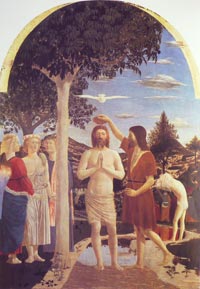 |
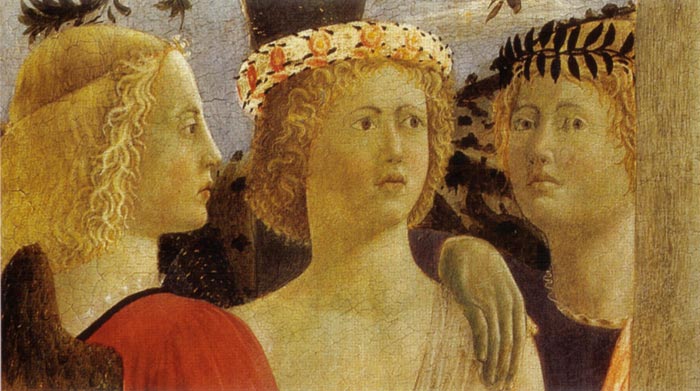 |
Piero della Francesca, The Baptism of Christ, detail (c. 1448-1450) - Tempera on panel, 168 x 116 cm, National Gallery, London
|
The three angels on the left, with their pale but round faces, are reminiscent of the groups of children sculpted by Luca della Robbia for the Cantoria in Florence Cathedral (1432-38). Even their blonde hair, decorated with garlands, is clearly inspired by Luca's models. The face of the angel in the centre, with his fixed gaze, brings to mind Domenico Veneziano paintings in the mid-1430s. The three angels wear different clothes and, different from the traditional iconography, are not supporting Christ's garments, but are holding each other's hands. This would be an allusion to the contemporary council of Florence (1439), whose goal was the unification of the Western and Eastern Churches. The Camaldolese Ambrogio Traversari was in fact a strong supporter of the union. Such symbolism would be also confirmed by the presence, behind the neophyte on the right, of figures dressed in an oriental fashion.
|
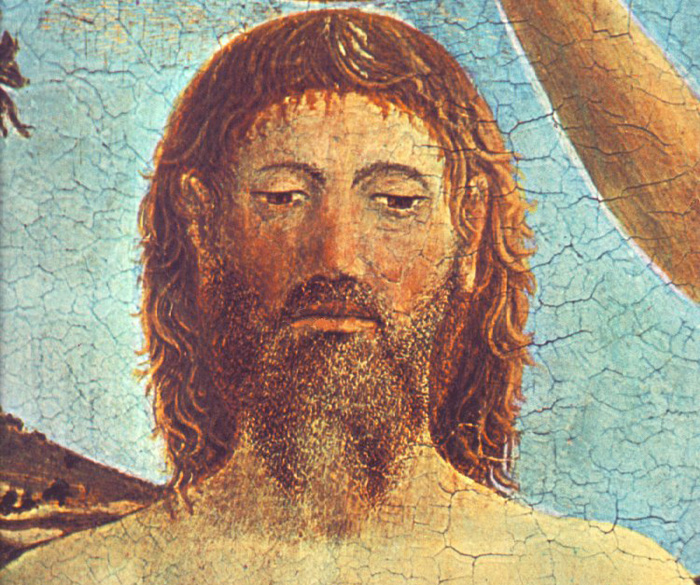 |
Piero della Francesca, The Baptism of Christ, detail (c. 1448-1450) - Tempera on panel, 168 x 116 cm, National Gallery, London
|
Piero's Baptism of Christ has a similar accentuation of depth, coupled with a brightness that is permeated by light, as in St. Jerome and a Donor. The painting, which is semicircular at the top, is the central panel of an altar in several parts, produced by Matteo di Giovanni in about 1465. The lavish construction of the frame leads us to the conclusion that the structure was destined to be the main altar in a larger church. Some art historians consider this piece to be a work by the mature Piero in about 1460, whereas others give it a particularly early date, as its light pastel colors are reminiscent of Domenico Veneziano's altar in Santa Lucia de' Magnoli, created in about 1445.
It has repeatedly been mentioned in art historical research that the construction of the picture is based on geometric shapes. One of the suggestions is that the composition is based on the Platonic shapes with which Piero deals in his treatise "De Corporibus Regularibus". The painting is constructed of simple basic forms: a semicircle sitting on a square. If a sketch of an equilateral triangle with the tip pointing down were drawn in the square, it would meet the toes of Christ's engaged leg. In the centre of the triangle are the folded hands of the Son of God, and the centre of the base line is marked by the dove. The square, circle and equilateral triangle are shapes whose special feature lies in the fact that they are regular and cannot be simplified further. That they not only determine the format but also the posture and shape of Christ in this picture means that they must be interpreted as a first reference to the theme of the depiction: in the Baptism, Christ is revealed to us as the Son of God. In consequence, all other pictorial figures - with one exception - are arranged by Piero parallel to the frontal figure of Christ, which is not overlapped by anything else. The most conspicuous example of this is St. John the Baptist. The fingers of his left hand do not extend beyond the limits of his garment - as if to maintain an imaginary border.
In this baptismal scene, the laws of nature appear to have been annulled: the river has stopped flowing at the point where Christ's feet are standing in the bed of the river. In accordance with iconographical tradition, Jesus is shown being baptized in the Jordan. Piero was particularly interested in using the water as a reflective surface. This preference, entirely related to his endeavors for perspective, made it possible to achieve heightened spatial effects. It was, however, also problematic in that it was not traditionally permitted to depict Christ as a reflection or simply doubled. Almost unnoticeable reflections around the ankles of the two protagonists show that they are standing in water. The way in which Piero della Francesca paints the river as flowing almost vertically from the middle distance of the picture into the foreground is unusual in 15th-century Italian painting.
Piero della Francesca was renowned in his times as an authority on perspective and geometry: his attention to the theme is shown by John's arm and leg, which form two angles of the same size. |
|
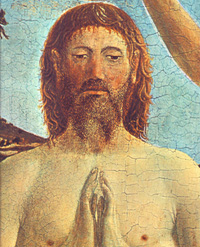
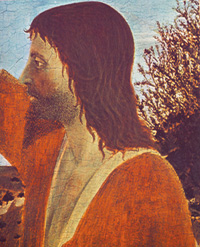
|
| |
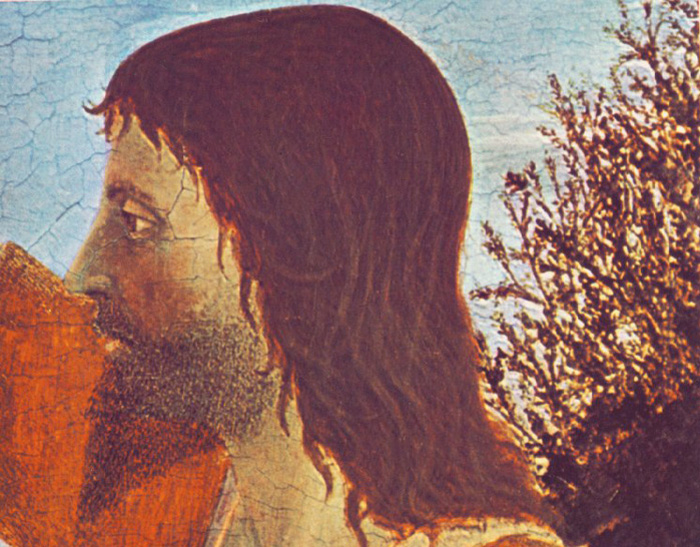 |
Piero della Francesca, The Baptism of Christ, detail (c. 1448-1450) - Tempera on panel, 168 x 116 cm, National Gallery, London |
|
|
|
| |
|
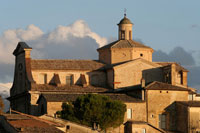
|
|
|
|
|
Montefalco |
|
|
|
Arezzo, Piazza Grande |


Holiday accomodation in Tuscany | Podere Santa Pia | Artist and writer's residency
|
| |
|
|
|
|

. |
|
|
Podere Santa Pia |
|
Podere Santa Pia, garden view, April |
|
View from Podere Santa Pia
on the coast and Corsica |
|
|
|
|
|
Monte Oliveto Maggiore abbey |
|
Abbey of Sant 'Antimo |
|
Montalcino |
| |
|
|
|
|
This page uses material from the Wikipedia article Piero della Francesca, and The Baptism of Christ (Piero della Francesca) published under the GNU Free Documentation License.
|
'Piero della Francesca is one of the most admired 15th-century Italian painters. The cool colour palette and geometrical compositions contribute to the refined and meditative nature of his works.
Piero was born in Borgo Sansepolcro, in Tuscany. He worked in various central Italian towns, but retained links with Sansepolcro, visible in the background of the 'Baptism of Christ'. The distinctive rolling hills are depicted in a number of his works, such as 'The Nativity'. We know nothing of Piero's training, and the chronology of his works is hard to establish as many are lost. By 1439 he was working in Florence with Domenico Veneziano, whose treatment of space, like that of Uccello, must have influenced him.Piero was also a mathematical theorist. This interest is reflected in the clearly defined volume of the figures and accurate perspective in his works. It is balanced by a naturalism which derived from Netherlandish art. His patrons were among the most powerful men in Italy: the Duke of Urbino, Sigismund Malatesta in Rimini, and Pope Nicholas V in Rome. According to tradition, Piero taught Signorelli. Vasari says he became blind in old age. He was buried in Sansepolcro.'
The National Gallery bought it in 1861 from the Camaldolese Abbey at Borgo San Sepolcro, his native town.
'This panel was the central section of a polyptych. It may be one of Piero's earliest extant works. Side panels and a predella were painted in the early 1460s, by Matteo di Giovanni (active 1452; died 1495). The altarpiece was in the chapel of Saint John the Baptist in the Camaldolese abbey (now cathedral) of Piero's native town, Borgo Sansepolcro. The town, visible in the distance to the left of Christ, may be meant for Borgo Sansepolcro: the landscape certainly evokes the local area.
The dove symbolises the Holy Spirit. It is foreshortened to form a shape like the clouds. God the Father, the third member of the Trinity, may originally have been represented in a roundel above this panel.'
http://www.nationalgallery.org.uk |
|
|
![]()

